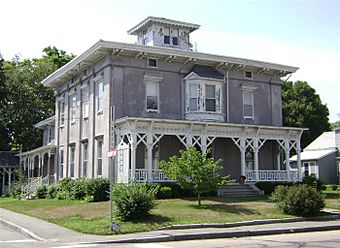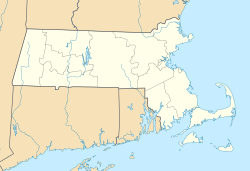Samuel Colby House facts for kids
Quick facts for kids |
|
|
Samuel Colby House
|
|
 |
|
| Location | 74 Winthrop St., Taunton, Massachusetts |
|---|---|
| Built | 1869 |
| Architectural style | Stick/Eastlake, Italianate |
| MPS | Taunton MRA |
| NRHP reference No. | 84002103 |
| Added to NRHP | July 5, 1984 |
The Samuel Colby House is a very old and special home. It is located at 74 Winthrop Street in Taunton, Massachusetts. This house was built in 1869 for a well-known local businessman. It is one of the best examples of a fancy building style called Italianate architecture in the city. The house was added to the National Register of Historic Places in 1984. This means it is an important historical site.
The Samuel Colby House: A Historic Home
The Samuel Colby House stands south of downtown Taunton. You can find it on the south side of Winthrop Street. It is right where Winthrop Street meets Walnut Street.
What Does This House Look Like?
The house is a two-story building made of wood. It has a smooth, stucco finish on the outside. The roof is low and gently sloped. A large square tower, called a cupola, sits on top of the roof. The main roof has long edges that stick out. These edges are decorated with pairs of small supports called brackets. The cupola's roof has a fancy, hanging border.
The front of the house is three sections wide. Above the main door in the center, there is a bay window with many sides. Thin, flat columns called pilasters separate these sections. A porch runs all the way across the front of the house. This porch has a flat roof with more brackets. It is also decorated with a lot of wooden patterns, known as stickwork. Another similar porch is on the side of the back part of the house. This porch faces Walnut Street.
Who Was Samuel Colby?
The Samuel Colby House was built in 1869. It was built for Samuel Colby himself. He was a very important person in Taunton. Samuel Colby made and sold clothes for men and boys. He had his own store in the Union Block, right in downtown Taunton.
This house is special because it has not changed much since it was built. It is one of the best-preserved homes from after the American Civil War. It is also a great example of the fancy Italianate style of building.



